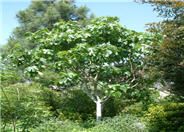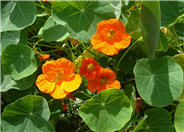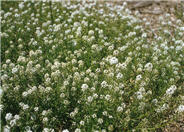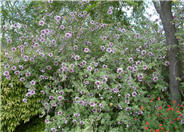
Common name:Fig Edible
Botanical name:Ficus carica
This small tree produces wonderful figs that are a brownish red color.

Common name:Garden Nasturtium
Botanical name:Tropaeolum majus
This annual groundcover/vine and will grow less than 1' tall, but will spread and climb up to 6' tall. Nasturtium has 2" light green leaves with edible, red, orange, yellow, or white flowers that are in constant bloom throughout the warm season. This plant usually reseeds, with new plants emerging in early spring.

Common name:Sweet Alyssum
Botanical name:Lobularia maritima
Lobularia maritima is an annual. It is a low branching, trailing plant to 1' tall, with narrow or lance-shaped leaves .5"-2" long. There are tiny, four-petaled, white flowers crowded in clusters.

Common name:Bearded Iris
Botanical name:Iris Bearded Hybrids
This perennial will grow 1'-3' tall and has medium sized, blue green leaves with flowers of different colors that bloom in spring. It needs well draining soil and full sun. Many are fragrant and rebloom several times a year. Plant rhizomes in Sept or Oct. They need water once a week during the hot spells. Top dress with compost and gypsum in January and August.

Common name:Mediterranean Tree Mallow
Botanical name:Lavatera maritima
This large, shrubby perennial grows up to 6' and has profuse lavender pink flowers with maroon highlights. From the Mallow family, the flowers are produced year round and are especially showy in the fall.
| Designer: Anon | Terraced Hillside |
Photographer: GardenSoft |
Soils and Compost:
Maintain a two to four inch layer of mulch on the soil surface to reduce weeds, infiltrate rain water, and reduce compaction.
Water Saving Tip:
In general, lawns only need to be watered once every three days.
Check your irrigation controller and reduce watering times if necessary.
Integrated Pest Management:
Remove irrigation water and fertilizer from areas where you don't want weeds to grow.
